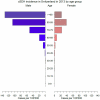Incidence, therapy, and outcome in the management of chronic subdural hematoma in Switzerland: a population-based multicenter cohort study
- PMID: 37780710
- PMCID: PMC10540067
- DOI: 10.3389/fneur.2023.1206996
Incidence, therapy, and outcome in the management of chronic subdural hematoma in Switzerland: a population-based multicenter cohort study
Abstract
Background: Chronic subdural hematoma (cSDH) is a disease affecting mainly elderly individuals. The reported incidence ranges from 2.0/100,000 to 58 per 100,000 person-years when only considering patients who are over 70 years old, with an overall incidence of 8.2-14.0 per 100,000 persons. Due to an estimated doubling of the population above 65 years old between 2000 and 2030, cSDH will become an even more significant concern. To gain an overview of cSDH hospital admission rates, treatment, and outcome, we performed this multicenter national cohort study of patients requiring surgical treatment of cSDH.
Methods: A multicenter cohort study included patients treated in 2013 in a Swiss center accredited for residency. Demographics, medical history, symptoms, and medication were recorded. Imaging at admission was evaluated, and therapy was divided into burr hole craniostomy (BHC), twist drill craniostomy (TDC), and craniotomy. Patients' outcomes were dichotomized into good (mRS, 0-3) and poor (mRS, 4-6) outcomes. A two-sided t-test for unpaired variables was performed, while a chi-square test was performed for categorical variables, and a p-value of <0.05 was considered to be statistically significant.
Results: A total of 663 patients were included. The median age was 76 years, and the overall incidence rate was 8.2/100,000. With age, the incidence rate increased to 64.2/100,000 in patients aged 80-89 years. The most prevalent symptoms were gait disturbance in 362 (58.6%) of patients, headache in 286 (46.4%), and focal neurological deficits in 252 (40.7%). CSDH distribution was unilateral in 478 (72.1%) patients, while 185 presented a bilateral hematoma with no difference in the outcome. BHC was the most performed procedure for 758 (97.3%) evacuations. CSDH recurrence was noted in 104 patients (20.1%). A good outcome was seen in almost 81% of patients. Factors associated with poor outcomes were age, GCS and mRS on admission, and the occurrence of multiple deficits present at the diagnosis of the cSDH.
Conclusion: As the first multicenter national cohort-based study analyzing the disease burden of cSDH, our study reveals that the hospital admission rate of cSDH was 8.2/100,000, while with age, it rose to 64.2/100,000. A good outcome was seen in 81% of patients, who maintained the same quality of life as before the surgery. However, the mortality rate was 4%.
Keywords: cSDH; chronic subdural hematoma; incidence; management; multicentric study; neurosurgery; outcome; therapy.
Copyright © 2023 El Rahal, Beck, Ahlborn, Bernasconi, Marbacher, Wanderer, Burkhardt, Daniel, Ferrari, Hausmann, Kamenova, Kothbauer, Lutz, Mariani, Alfieri, Schöni, Schucht, Raabe, Regli, Kuhlen, Seule, Soleman, Starnoni, Zaldivar, Zweifel, Schaller and Fung.
Conflict of interest statement
The authors declare that the research was conducted in the absence of any commercial or financial relationships that could be construed as a potential conflict of interest.
Figures



Similar articles
-
Comparative Study of Single Burr-Hole Craniostomy versus Twist-Drill Craniostomy in Patients with Chronic Subdural Hematoma.Asian J Neurosurg. 2019 Apr-Jun;14(2):513-521. doi: 10.4103/ajns.AJNS_37_19. Asian J Neurosurg. 2019. PMID: 31143272 Free PMC article.
-
The management and outcome for patients with chronic subdural hematoma: a prospective, multicenter, observational cohort study in the United Kingdom.J Neurosurg. 2017 Oct;127(4):732-739. doi: 10.3171/2016.8.JNS16134. Epub 2016 Nov 11. J Neurosurg. 2017. PMID: 27834599
-
The management and outcome for patients with chronic subdural hematoma: a prospective, multicenter, observational cohort study in the United Kingdom.J Neurosurg. 2017 Mar 17:1-8. doi: 10.3171/2016.8.JNS16134.test. Online ahead of print. J Neurosurg. 2017. PMID: 28306417
-
Burr hole craniostomy vs. minicraniotomy of chronic subdural hematoma: a systematic review and meta-analysis.Eur Rev Med Pharmacol Sci. 2022 Jul;26(14):4983-4990. doi: 10.26355/eurrev_202207_29284. Eur Rev Med Pharmacol Sci. 2022. PMID: 35916794
-
Chronic Subdural Hematoma in Elderly Patients: Is This Disease Benign?Neurol Med Chir (Tokyo). 2017 Aug 15;57(8):402-409. doi: 10.2176/nmc.ra.2016-0337. Epub 2017 Jun 26. Neurol Med Chir (Tokyo). 2017. PMID: 28652561 Free PMC article. Review.
Cited by
-
Middle meningeal artery embolization in chronic subdural hematoma: a new tool in geriatric care.Eur Geriatr Med. 2025 Feb;16(1):1-3. doi: 10.1007/s41999-024-01121-8. Eur Geriatr Med. 2025. PMID: 39621205 No abstract available.
-
Effects of Angiotensin-Converting Enzyme Inhibition on the Recurrence and Internal Structure of Chronic Subdural Hematomas.J Clin Med. 2024 Aug 6;13(16):4591. doi: 10.3390/jcm13164591. J Clin Med. 2024. PMID: 39200732 Free PMC article.
-
Management of chronic subdural hematoma in spontaneous intracranial hypotension.Brain Spine. 2025 Jul 3;5:104320. doi: 10.1016/j.bas.2025.104320. eCollection 2025. Brain Spine. 2025. PMID: 40689141 Free PMC article.
References
-
- Kevin K, Victoria AV. Aging World: 2001. International Population Reports. Govt Reports Announcements & Index (GRA&I), Issue 07, 2002 (2001).
LinkOut - more resources
Full Text Sources
Medical
Research Materials

